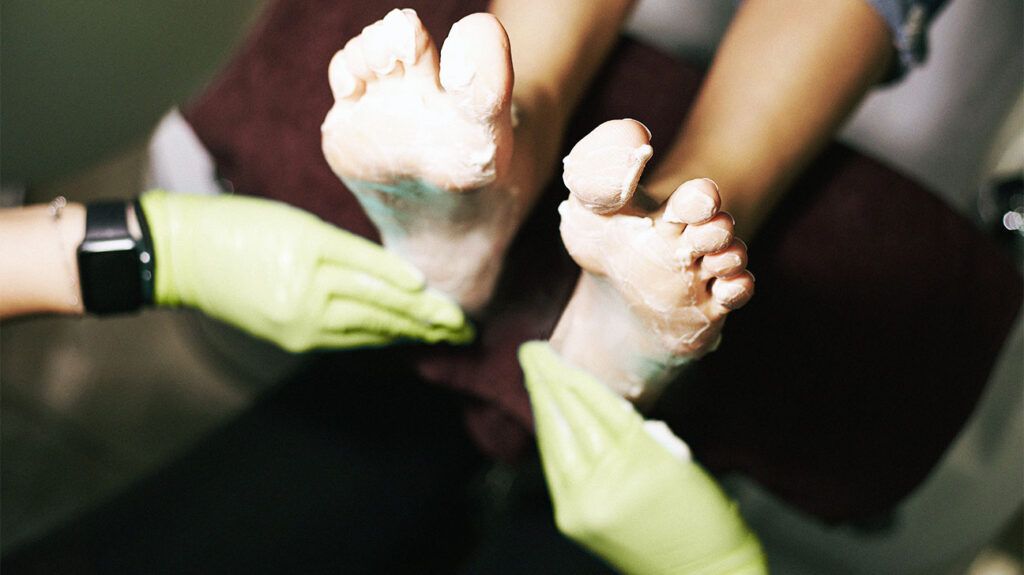No, dyshidrotic eczema is not contagious. Despite its resemblance to other contagious conditions, such as scabies, dyshidrotic eczema cannot pass from one person to another.
Dyshidrotic eczema causes small, fluid-filled blisters to appear on the skin, often on the hands and feet. These blisters can cause intense itching and discomfort.
Scientists do not fully understand the cause of dyshidrotic eczema, but factors such as stress, allergies, and exposure to certain irritants may play a role.
People with a family history of eczema or allergic conditions are more likely to develop dyshidrotic eczema, which could also make it seem as though it is contagious.
This article explores dyshidrotic eczema, its causes, diagnosis, and treatments.

Dyshidrotic eczema, or pompholyx, is not contagious. This means it cannot spread from one person to another through touching a person’s skin, or any surfaces or objects they have touched.
This distinguishes dyshidrotic eczema from some other skin conditions, which can spread between individuals.
However, if multiple people in a shared environment all begin developing skin symptoms around the same time, it is important to contact a doctor.
Dyshidrotic eczema can resemble some skin conditions that are contagious. A doctor can make sure a person has the right diagnosis.
While the exact cause of dyshidrotic eczema is unknown, various factors may contribute to its onset.
For example, people with a family history of eczema, asthma, or other allergic conditions are more likely to develop dyshidrotic eczema, suggesting a genetic component to its occurrence.
Dyshidrotic eczema is also more common in people who also have another type of eczema.
Factors that may contribute to flare-ups of symptoms include:
A flare-up of other conditions that affect the immune system, such as allergies, could also lead to a flare-up of eczema.
Other factors that may have an association with dyshidrotic eczema include smoking, aspirin use, and the oral contraceptive pill.
Dyshidrotic eczema is not a fungal infection in itself. However, some older research has noted that people with tinea pedis, or athlete’s foot, can also experience symptoms resembling dyshidrotic eczema.
This does not mean this type of eczema is an infection, though.
It may be that the blisters are a response to fungus being on the skin, but more research is necessary to understand the relationship.
If a person has reason to suspect they have a fungal infection in addition to eczema, they should speak with a doctor. The symptoms of a fungal infection can include:
- scaly or peeling skin
- cracked skin, especially in folds of the skin, or between toes or fingers
- thickened or pale skin
- itchiness, burning, or stinging
Dyshidrotic eczema can be a chronic condition, which means it may persist for long periods, with symptoms that fluctuate over time. Many individuals experience recurring episodes.
The unpredictable nature of these flare-ups can make dyshidrotic eczema challenging to manage, as long periods of remission can be followed by sudden flare-ups.
While there is currently no permanent cure for dyshidrotic eczema, individuals can manage the condition effectively with a combination of medical treatments and lifestyle adjustments.
Diagnosing dyshidrotic eczema
They will also take a detailed medical history, asking questions about the individual’s symptoms, onset and duration of flare-ups, possible triggers, and any family history of eczema or other skin conditions.
To rule out other conditions, the clinician may conduct additional tests. They might perform patch testing to identify potential allergens or irritants that could trigger the eczema.
During patch testing, they apply small amounts of various substances to the skin. They then examine the skin for allergic reactions, which can help pinpoint specific triggers.
Treating dyshidrotic eczema involves a combination of strategies aimed at relieving symptoms, managing flare-ups, and preventing future episodes. A treatment plan may include:
- Emollients: Regular use of moisturizers keeps the skin hydrated, which is essential for preventing dryness.
- Topical corticosteroids: Creams such as hydrocortisone, clobetasol, or betamethasone may help reduce inflammation, alleviate the discomfort of blisters, and accelerate the healing process.
- Antihistamines: These medications help control itching, which can be particularly intense during flare-ups.
- Light therapy: In cases where topical treatments are insufficient, clinicians may recommend phototherapy. This treatment uses specific wavelengths of light to reduce inflammation and improve skin symptoms.
- Systemic medications: For severe or persistent dyshidrotic eczema, a healthcare professional may prescribe oral or injectable medications that work throughout the body. Examples include methotrexate, ciclosporine, azathioprine, mycophenolate, oral retinoids, and biologic agents such as dupilumab (Dupixent).
To manage dyshidrotic eczema effectively, it is also crucial for individuals to identify and avoid the specific triggers that provoke their flare-ups. This could involve:
- avoiding allergens such as nickel
- reducing stress by practicing relaxation techniques or trying talk therapy
- wearing gloves when cleaning or working with chemicals
- treating coexisting conditions, such as fungal infections or excessive sweating
If a person comes into contact with a trigger, they should wash their hands immediately. Keeping the nails short and avoiding scratching may also help.
Dyshidrotic eczema is not contagious and cannot pass between people. While the exact cause is unknown, there appears to be a link to genetics and allergies. Factors such as stress, dry skin, harsh chemicals, or sweating may make it worse.
The condition can be chronic, but it is manageable with appropriate treatment and lifestyle adjustments. An accurate diagnosis and treatment can help control symptoms and improve the overall quality of life for those affected.